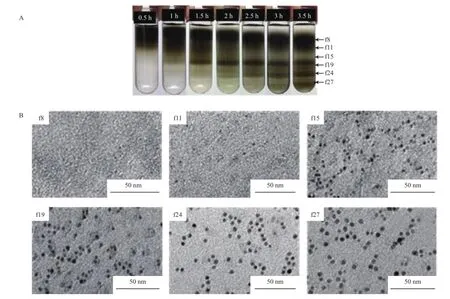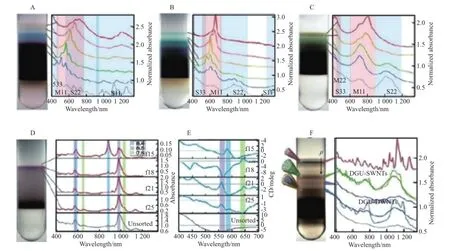纳米材料的密度梯度离心分离的研究进展(上)
2017-01-20李鹏松孙晓明
李鹏松,蔡 钊,李 莉,罗 亮,邝 允,孙晓明
(北京化工大学 化工资源有效利用国家重点实验室,北京 100029)
纳米材料的密度梯度离心分离的研究进展(上)
李鹏松,蔡 钊,李 莉,罗 亮,邝 允,孙晓明
(北京化工大学 化工资源有效利用国家重点实验室,北京 100029)
纳米材料的性能与它的尺寸及形貌有着密切的联系。对于液相合成的大多数纳米材料,很难控制它们的尺寸和形貌具有严格的单一性。通过纳米分离手段获得单分散的功能纳米材料对其应用和发展有重大的意义。密度梯度离心法由于分离体系具有高度的可调控性,对不同形貌、尺寸、合成体系的纳米材料的分离纯化具有普适性和高效性。对密度梯度离心分离的原理、方法、体系与应用进行了阐述,总结了该领域近年来的一些研究进展,并对其发展前景进行了展望。
纳米材料;纳米分离;密度梯度离心;单分散纳米结构
纳米材料是三维空间尺度至少有一维处于纳米量级(0.1~100 nm)的材料。由于这类材料具有巨大的外表面积以及由小尺寸所产生的量子尺寸效应,从而产生不同于普通材料的特殊性能,进而在光学、电学和磁学等领域具有巨大的应用价值。纳米材料的性能与它的尺寸和形貌有着密切的联系。长期以来,人们主要依靠合成方法的改进来获得尺寸相对单一的单分散纳米颗粒。但由于温度场、浓度场等合成条件的不均一性,有时会使得单分散纳米颗粒的获得较为困难。合成的产物中各种尺寸和形貌的纳米颗粒混杂在一起,会造成一定的颗粒分布,这就大大限制了纳米材料性能的单一性,从而限制了它的有效利用。因此,想要获得单一尺寸或形貌的纳米材料,发展高效纳米分离方法势在必行。
密度梯度离心分离由于分离体系具有高度的可调控性,对不同形貌、不同尺寸、不同合成体系的纳米材料的分离纯化具有普适性和高效性,从而成为纳米材料的高效分离方法。
本文对密度梯度离心分离的原理、方法、体系与应用进行了阐述,总结了该领域近年来的一些研究进展,并对其发展前景进行了展望。
1 密度梯度离心法简介
纳米材料的性质与其大小或形貌有着密切的关系[1-3],然而传统无机合成得到的纳米结构大都具有一定的尺寸分布[4-5]。因此,如何获得尺寸、形貌单一的单分散纳米结构对纳米材料的应用尤为重要。尽管无机纳米材料的液相合成方法发展了近30年,但单分散纳米结构的可控合成还局限在仅有的几个体系,对于大多数液相合成的纳米材料,后期的分离纯化必不可少。现有用于分离的方法主要包括色谱法[6]、磁分离法[7]、膜分离法[8]、离心沉降法[9-11]以及电泳法[12-14]等,然而这些分离方法对于特定的分离体系具有较大的局限性。因此,建立一种高效、通用的分离方法势在必行。密度梯度离心法是由于分子生物学不断发展而建立起来的一种精确的实验分离方法,起初广泛地应用于蛋白、线粒体、溶酶体、植物病毒、RNA、DNA等生物大分子的分离纯化[15-20]。而纳米材料在尺度上与生物大分子类似,因此,对于纳米材料的分离纯化,密度梯度离心法同样适用。
2005年,Arnold等[21]首先将密度梯度离心分离应用于纳米科学,他们成功地利用这种完全的液相分离方法把单壁碳纳米管按直径的大小进行了分离,实现了生物学到纳米科学的跨越。随后,Hersam课题组、Sun课题组和Ozin课题组对纳米材料的分离纯化做了深入的研究,得到了各种单分散的纳米材料,并建立了较为完善的分离体系。本文从探讨密度梯度离心法的原理入手,介绍了不同的分离体系,探讨了密度梯度离心法在纳米材料分离纯化与反应机理研究等方面的应用。
2 密度梯度离心分离的原理及分类
密度梯度离心法就是用介质在离心管中配制成一个阶梯的或连续的密度梯度,然后把纳米颗粒置于梯度的顶部,通过离心场作用使纳米颗粒分离的一种纯化方法[22]。在离心管中,具有不同特征的纳米颗粒受到离心力作用后会产生不同的运动速度,由于纳米颗粒的运动速度不同,使得不同特征的纳米颗粒得到分离和纯化[23]。不同大小的纳米颗粒在多层密度梯度上的分离和核壳结构模型及其表观密度表达式[24]见图1。

图1 不同大小的纳米颗粒在多层密度梯度上的分离(A)和核壳结构模型及其表观密度表达式(B)[24]Fig.1 Schematic diagram of density gradient centrifugation tube(A) and hydraodynamical colloidal nanoparticle model(B)[24].ρ:density of medium;d:sedimentation distance;ρc:core density;ρh:shell density;ρp:core-shell apparent density;r:radius of nanoparticle;D:thickness of solvation layer.
具体来说,在密度梯度离心中,利用不同密度的介质在离心管中配制密度梯度,介质要求稳定,不能与要分离的颗粒产生反应。把要分离的纳米粒子放到离心管的上层,并施加一个离心力,使颗粒开始加速运动,当此力与浮力、粘滞阻力达到平衡后[25],不同的纳米颗粒会有不同的沉降速率[24]。对于球形颗粒,其沉降速率可以表达为:

式中,v为沉降速率,cm/s;r为纳米颗粒半径,nm;D为溶剂化层厚度,nm;ρp为纳米颗粒的表观密度,g/cm3;ρm为介质的密度,g/cm3;ηm为介质的黏度,Pa·s;g′为离心场加速度,m/s2。由式(1)可见,ρm和ηm的增大均会使沉降速率变小,而较大颗粒会具有较大的沉降速率,所以具有较大密度和较大半径的纳米颗粒可先沉降到离心管的下部。当离心力被撤掉时,纳米颗粒由于受阻力的影响最终会分布在离心管的不同位置(如图1A所示),图1B 为球形纳米颗粒在梯度介质中的核壳结构模型,外层为溶剂化层,厚度为D,而纳米颗粒的半径为r,由此可以得到ρp。
密度梯度离心法一般可分为两种:等密度离心法[26]和速率区带离心法[27]。在离心力的作用下,低密度的纳米粒子会沉降到与它表观密度相等的梯度密度对应区域中,不管加多大的离心力和多长的离心时间,纳米粒子都会停留在相应的区域,反映在沉降速率方程上就是ρp=ρm。对于高密度的纳米粒子,由于其表观密度比梯度介质密度大(即ρp>ρm),在相对较长的时间后,所有的纳米粒子都会沉降到离心管的底部,因此在用速率区带离心法时一定要选择合适的离心力和离心时间。等密度离心法和速率区带离心法的示意图见图2。从图2可看出,在做纳米颗粒分离时,对于这两种分离方法的选择主要取决于颗粒的表观密度与介质密度的关系:当要分离的颗粒的表观密度与介质密度相等时就选用等密度离心法;当要分离的颗粒的表观密度大于介质密度时就选用速率区带离心法。一般的金属纳米颗粒的表观密度都很大,很难找到与它密度相等的梯度介质,所以一般选用速率区带离心法。因为碳纳米材料的密度相对较小,所以一般分离碳纳米材料时可以采用等密度离心法。

图2 等密度离心法(A)和速率区带离心法(B)示意图Fig.2 Schematic illustration of typical isopycnic separation(A) andrate-zonal separation(B).ρm:density of gradient medium.
3 零维纳米材料的分离
零维纳米颗粒主要包括原子团簇、人造原子和纳米微粒。它们都有着显著的纳米尺寸效应[28]。对于纳米材料,尺寸的单一性对纳米尺寸效应有很大的影响,分离得到单分散的纳米颗粒显得尤为重要。
3.1 水相密度梯度分离FeCo@C等水溶性纳米颗粒
在密度梯度离心法制备单分散零维材料的研究中,梯度介质是影响分离效果的关键因素,因此梯度介质的选择要考虑很多因素:为了避免梯度介质对纳米颗粒的影响,梯度介质必须是惰性的,且还要与纳米颗粒有好的相容性,不会导致颗粒的聚沉;为了得到很好的分离效果,还要考虑密度梯度的密度范围和黏度与纳米颗粒的匹配性;最好梯度介质可以很容易地从分离产物中剔除,且不产生污染。
对于典型的水溶性纳米颗粒,如FeCo@C纳米晶,它显示了卓越的磁学性能,在生物标签和核磁成像中有很好的应用前景。然而合成的局限和较强的磁性使得单分散FeCo@C纳米晶的获得较困难。Sun等[24]为此建立了水相密度梯度分离方法,将制备的平均尺寸为4 nm的FeCo@C纳米晶用聚乙二醇分子充分包覆并在碘克沙醇密度梯度液中进行分离,最终得到1.5~5.6 nm的纳米晶,展示出密度梯度分离优越的精细度(如图3所示)。与传统的渗析、过滤、色谱和电泳等方法不同,该方法在液相密度梯度中完成分离,避免了由于固-固相互作用造成的胶体颗粒的损失和分离体系的失效,并可通过调整密度梯度的梯度差、温度和分离时间等参数达到不同的分离效果,具有通用、高效、省时、产品无损失和体系易重建等优点,展现出很好的分离效果和巨大的应用潜力。
3.2 有机密度梯度分离Au、CdSe和硅纳米晶等油溶性纳米颗粒
在有机体系中合成纳米颗粒的可控性以及单分散性均高于水相体系[29-30],然而即使在有机体系中也不能达到完全的单分散。因此,为了获得更加单分散的试样,同时为了避免颗粒聚集,发展高精度的有机相分离方法势在必行。Bai等[31]发现四氯化碳和环己烷的混合溶液能够溶解大部分有机相合成的颗粒,同时能够提供较宽的密度梯度范围,非常适合油溶性纳米颗粒的密度梯度离心分离。他们利用环己烷和四氯化碳配制成有机密度梯度液,成功地把在油胺中合成的Au胶体纳米粒子按尺寸大小进行分离,得到了平均尺寸分别为4.8,7.2,8.0,9.3,10.9 nm的Au胶体颗粒,且尺寸的误差范围不超过1.5 nm(如图4所示)。
与水相密度梯度分离法相比,有机体系的分离可减少纳米粒子不必要的团聚,使其保持合成出来的原貌,且有机密度梯度介质不含难挥发物质,所以密度介质在经过分馏或蒸发后可以不留下任何残留,有利于得到单分散胶体的纯净物。因此,有机相梯度介质在某些方面有一定优势。同样Bai等[31]还利用类似的方法得到了单分散的硒化镉量子点(直径2.5~5.5 nm,直径误差范围小于0.5 nm),从而为研究硒化镉量子点尺寸大小与其荧光性能的关系提供了可能。

图3 密度梯度离心分离FeCo@C颗粒[24]Fig.3 Separation of FeCo@C nanoparticles by density gradient centrifugation[24].A Digital camera images of ultracentrifuge tubes taken in 30 min interval;B TEM images of diferent samples labeled in A

图4 密度梯度离心分离有机相Au纳米颗粒[31]Fig.4 Separation of Au nanoparticles suspended in organic media by density gradient centrifugation[31].A Digital images of ultracentrifuge vessels containing Au nanoparticles before(left vessel) and after(right vessel) separation at 25 000 r/min for 12 min;B TEM images of typical fractions The graph in the bottom right corner of B showed a comparison of the size distribution diference before(red columns in the upper section) and after(colored columns in the lower section) centrifugation separation,each size histograms was measured from at least 200 particles.
由于纳米尺寸效应,不同大小的半导体纳米晶会有不同的物理性能[32],这使得它在光电设备[33-34]以及生物医学设备[35-36]上有广泛应用。通过研磨氢氟酸刻蚀法[37]、等离子体合成法[38]或SiCl4溶液还原法[39]得到的硅纳米颗粒大多数是多分散的。为了解决单分散问题,Mastronardi等[40]通过油相密度梯度离心法实现了烷基包覆纳米硅晶的尺寸分离(如图5所示)。

图5 密度梯度离心分离硅纳米颗粒[40]Fig.5 Separation of Si nanoparticles by density gradient centrifugation[40].A Schematic of decyl-capped Si;B Images of a colloidal suspension of decyl-capped Si in hexane under ambient light(left) and photoexcitation(right);C Size analysis of monodisperse Si fractions;D PL spectra of Si fractions extracted from fuorescence maps at 345 nm for diferent DGU fractions,the inset showed the wavelength of the peak center of the DGU fraction plotted against the fraction number,summarizing the blue shift in PL observed with increasing fraction number
Miller等[28]也通过密度梯度离心法得到了高度单分散的硅纳米晶体,并对其量子产率、荧光寿命和光致发光性质进行了研究。研究结果表明,具有高度统一尺寸的硅纳米晶体减小了发射线的宽度且量子产率对尺寸大小有着很高的依赖性。类似地,Speranskaya等[41]在有机溶剂里合成了具有核壳结构的CuInS2/ZnS纳米量子点,然后用密度梯度离心法提纯得到纯度较高的CuInS2/ZnS纳米量子点,在免疫分析领域有很高的应用价值。因此,密度梯度离心法不仅可实现零维纳米颗粒按尺寸分离,还可以对零维纳米材料进行纯化。
4 一维纳米材料的分离
密度梯度离心法在一维材料方面的应用主要集中在碳纳米管[42]上。由于碳纳米管的密度较小,一般是靠它的表观密度来实现分离[21,43-44]。传统的密度梯度离心法一般是用水相介质作为密度梯度介质,在分离碳纳米材料时就要用一些化学表面活性剂使疏水碳材料分散到水中,因此在水相分离碳纳米管时的表观密度主要取决于封装用的表面活性剂[45-46],表面活性剂的选择对分离效果有很大的调节性。例如,选用胆酸钠和十二烷基磺酸钠表面活性剂可以把单壁碳纳米管按直径的大小进行分离,且纯度可达99%[47](如图6A~6C所示)。此外,胆酸盐对不同手性的功能化单壁碳纳米管有着不同的吸附,这样可以对单壁碳纳米管的旋光性进行分离[48](如图6D~6E)。最近的研究结果表明,单壁碳纳米管的离心分离具有很强的适应性,特别是在电解质[49]、二萘嵌苯表面活性剂[50]、共价官能团活化[51]、梯度溶液[52]和有机溶剂[53]等方面。通过短暂而高效的操作,密度梯度离心法也可以用来分离不同长度的碳纳米管[54]。密度梯度离心分离碳纳米材料的可靠性已被很多实例证明:包括双壁碳纳米管[55-56](如图6F所示)、多壁碳纳米管[57]、单壁碳纳米管的超短胶囊[58]和单壁碳纳米角[59]等。Liu等[60]综述了采用密度梯度离心法分离碳纳米管。

图6 密度梯度离心分离碳纳米管[60]Fig.6 Separation of carbon nanotubes by density gradient centrifugation[60].ρrepresenting density, the right is the corresponding optical absorbance spectra.A-C Monodisperse metallic single-walled carbon nanotubes(SWNTs) are isolated using density gradient centrifugation;D-E DGU is used to sort Co/Mo catalyst SWNTs by chiral handedness using the chiral surfactant sodium cholate A Photograph of the centrifuge tube and corresponding optical absorbance spectra of SWNTs,labels starting with S and M representing semiconductor and metal,respectively;B Photograph of the centrifuge tube and corresponding optical absorbance spectra for laser ablation SWNTs;C Photograph of the centrifuge tube and corresponding optical absorbance spectra for arc discharge SWNTs;D Photograph of the centrifuge tube and corresponding optical absorbance spectra,f was the fraction number;E Circular dichroism(CD) spectra providing the direct evidence of enantiomer enrichment;F Monodisperse double-walled carbon nanotubes(DWNTs) isolated using DGU
另外,通过密度梯度离心富集的半导体型单壁碳纳米管,能使光电设备的光电交换比率和光电流显著增强[61]。同时,富集后的单壁碳纳米管具有很高的半导体场效应,频率高达80 GHz[62]。
长度大于100 nm的单壁碳纳米管很容易合成出来,然而更短的碳纳米管(长度小于100 nm)的合成一直是科学界的难题。不管是通过化学法还是物理法切割碳管获得超短碳纳米管,尺寸都不能得到有效的控制。利用密度梯度离心法对多分散的超短单壁碳纳米管进行分离,可以得到长度上比较单分散的碳纳米管[63]。Sun等[58]通过密度梯度离心分离,获得了平均长度仅为7 nm的短碳纳米管,将“最短碳纳米管”的长度降低了约一个数量级,并首次在超短纳米管上观察到纳米管光吸收与发射光谱的长度依赖性。Arnold等[46]通过等密度离心分离得到了不同粗细的单壁碳纳米管(其中97%的试样的直径从最大到最小只有0.02 nm的差别)。
同零维纳米材料一样,密度梯度离心法也可以对一维纳米材料进行纯化,Sun课题组[31]用实验对此进行了证明,他们把直径小于2 nm的Au纳米线与Au纳米颗粒进行混合,然后通过密度梯度离心技术把这两种形貌的纳米粒子分开,主要是利用纳米线(ρp=2.87 g/cm3)与纳米颗粒(ρp=8.61 g/cm3)表观密度的差别比较大,在密度梯度离心过程中,通过梯度介质对表观密度的选择性实现了纳米颗粒与纳米线的分离纯化。
[1]Park Tae-Jin,Papaefthymiou G C,Viescas A J,et al. Size-dependent magnetic properties of single-crystalline multiferroic BiFeO3nanoparticles[J]. Nano Lett,2007,7(3):766 -772.
[2]Park Seung-won,Jang Jung-tak,Cheon Jinwoo,et al. Shape-dependent compressibility of TiO2anatase nanoparticles[J]. J Phys Chem C,2008,112(26):9627 - 9631.
[3]Zheng Chan,Du Yuhong,Feng Miao,et al. Shape dependence of nonlinear optical behaviors of nanostructured silver and their silica gel glass composites[J]. Appl Phys Lett,2008,93(14):143108.
[4]Pileni Marie-Paule. The role of soft colloidal templates in controlling the size and shape of inorganic nanocrystals[J]. Nat Mater,2003,2(3):145 - 150.
[5]Walker D A,Browne K P,Kowalczyk B,et al. Self-assembly of nanotriangle superlattices facilitated by repulsive electrostatic interactions[J]. Angew Chem,Int Ed,2010,49(38):6760 - 6763.
[6]Jimenez V L,Leopold M C,Mazzitelli C,et al. HPLC of monolayer-protected gold nanoclusters[J]. Anal Chem,2003,75(2):199 - 206.
[7]Latham A H,Freitas R S,Schifer P,et al. Capillary magnetic feld fow fractionation and analysis of magnetic nanoparticles[J]. Anal Chem,2005,77(15):5055 - 5062.
[8]Akthakul A,Hochbaum A I,Stellacci F,et al. Size fractionation of metal nanoparticles by membrane filtration[J]. Adv Mater,2005,17(5):532 - 535.
[9]Zhao Wenting,Lin Li,Hsing I-Ming. Nucleotide-mediated size fractionation of gold nanoparticles in aqueous solutions[J]. Langmuir,2010,26(10):7405 - 7409.
[10]Anand M,Odom L A,Roberts C B. Finely controlled size-selective precipitation and separation of CdSe/ZnS semiconductor nanocrystals using CO2-gas-expanded liquids[J]. Langmuir,2007,23(13):7338 - 7343.
[11]Saunders S R,Roberts C B. Size-selective fractionation of nanoparticles at an application scale using CO2gas-expanded liquids[J]. Nanotechnology,2009,20(47):475605.
[12]DanieláLilly G. Free fow electrophoresis for the separation of CdTe nanoparticles[J]. J Mater Chem,2009,19(10):1390 - 1394.
[13]Arnaud I,Abid Jean-Pierre,Roussel C,et al. Size-selective separation of gold nanoparticles using isoelectric focusing electrophoresis(IEF)[J]. Chem Commun,2005(6):787 - 788.
[14]Hanauer M,Pierrat S,Zins I,et al. Separation of nanoparticles by gel electrophoresis according to size and shape[J]. Nano Lett,2007,7(9):2881 - 2885.
[15]McBain J W. Opaque or analytical ultracentrifuges[J]. Chem Rev,1939,24(2):289 - 302.
[16]Harvey E N. Physical and chemical constants of the egg of the sea urchin,Arbacia punctulata[J]. Biol Bull,1932,62(2):141 - 154.
[17]Brakke M K. Density gradient centrifugation:A new separation technique1[J]. J Am Chem Soc,1951,73(4):1847 -1848.
[18]Thomson J F,Klipfel F J. Fractionation of rat liver particulates using polyvinylpyrrolidone gradients[J]. Exp Cell Res,1958,14(3):612 - 614.
[19]Moritani Ichiro,Nishida Shinya,Murakami Masuo. The effect of conformation on reactivity.Ⅰ. Acetolysis of the trans-decalyl p-toluenesulfonates;1,3-diaxial interactions as a factor in the chemical behavior of decalyl derivatives[J]. J Am Chem Soc,1959, 81(13):3420 - 3423.
[20]de Duve C,Berthet J,Beaufay H. Gradient centrifugation of cell particles. Theory and applications[J]. Progr Biophys Biophys Chem,1959,9:325.
[21]Arnold M S,Stupp S I,Hersam M C. Enrichment of single-walled carbon nanotubes by diameter in density gradients[J]. Nano Lett,2005,5(4):713 - 718.
[22]金绿松,林元喜. 离心分离[M]. 北京:化学工业出版社,2008:7 - 15.
[23]宗晋. 离心沉降分析技术[M]. 北京:科学出版社,1983:54 - 70.
[24]Sun Xiaoming,Tabakman S M,Seo Won-Seok,et al. Separation of nanoparticles in a density gradient: FeCo@C and gold nanocrystals[J]. Angew Chem,Int Ed,2009,48(5):939 - 942.
[25]赵风章,栗振宝. 超速离心技术的基本原理与应用[J]. 白求恩医科大学学报,1983,9(6):119 - 124.
[26]Neuburger M,Journet E-P,Bligny R,et al. Purifcation of plant mitochondria by isopycnic centrifugation in density gradients of Percoll[J]. Arch Biochem Biophys,1982,217(1):312 - 323.
[27]Rickwood D. Preparative centrifugation: A practical approach[M]. Oxford:IRL Press at Oxford University Press,1992:404 - 417.
[28]Miller J B,van Sickle A R,Anthony R J,et al. Ensemble brightening and enhanced quantum yield in size-purifed silicon nanocrystals[J]. ACS Nano,2012,6(8):7389 - 7396.
[29]Peng Xiaogang,Manna L,Yang Weidong,et al. Shape control of CdSe nanocrystals[J]. Nature,2000,404(6773):59 - 61.
[30]Gaponik Nikolai,Talapin D V,Rogach A L,et al. Thiol-capping of CdTe nanocrystals:An alternative to organometallic synthetic routes[J]. J Phys Chem B,2002,106(29):7177-7185.
[31]Bai Lu,Ma Xiuju,Liu Junfeng,et al. Rapid separation and purifcation of nanoparticles in organic density gradients[J]. J Am Chem Soc,2010,132(7):2333 - 2337.
[32]Canham L T. Silicon quantum wire array fabrication by electrochemical and chemical dissolution of wafers[J]. Appl Phys Lett,1990,57(10):1046 - 1048.
[33]Talapin D V,Lee Jong-Soo,Kovalenko M V,et al. Prospects of colloidal nanocrystals for electronic and optoelectronic applications[J]. Chem Rev,2009,110(1):389 - 458.
[34]Colvin V L,Schlamp M C,Alivisatos A P. Light-emitting diodes made from cadmium selenide nanocrystals and a semiconducting polymer[J]. Nature,1994,370(6488):354 -357.
[35]Chan W C W,Nie Shuming. Quantum dot bioconjugates for ultrasensitive nonisotopic detection[J]. Science,1998,281(5385):2016 - 2018.
[36]Michalet X,Pinaud F F,Bentolila L A,et al. Quantum dots for live cells,in vivo imaging,and diagnostics[J]. Science,2005,307(5709):538 - 544.
[37]Liu Shu-Man,Yang Yang,Sato S,et al. Enhanced photoluminescence from Si nano-organosols by functionalization with alkenes and their size evolution[J]. Chem Mater,2006,18(3):637 - 642.
[38]Pi X D,Liptak R W,Nowak J D,et al. Air-stable full-visible-spectrum emission from silicon nanocrystals synthesized by an all-gas-phase plasma approach[J]. Nanotechnology,2008,19(24):245603.
[39]Zou Jing,Sanelle P,Pettigrew K A,et al. Size and spectroscopy of silicon nanoparticles prepared via reduction of SiCl4[J]. J Cluster Sci,2006,17(4):565 - 578.
[40]Mastronardi M L,Hennrich F,Henderson E J,et al. Preparation of monodisperse silicon nanocrystals using density gradient ultracentrifugation[J]. J Am Chem Soc,2011,133(31):11928 - 11931.
[41]Speranskaya E S,Beloglazova N V,Abé S,et al. Hydrophilic,bright CuInS2quantum dots as Cd-free fluorescent Labels in quantitative immunoassay[J]. Langmuir,2014,30(25):7567 - 7575.
[42]Hersam M C. Progress towards monodisperse single-walled carbon nanotubes[J]. Nat Nanotechnol,2008,3(7):387 -394.
[43]Arnold M S,Green A A,Hulvat J F,et al. Sorting carbon nanotubes by electronic structure using density diferentiation[J]. Nat Nanotechnol,2006,1(1):60 - 65.
[44]Green A A,Hersam M C. Ultracentrifugation of single-walled nanotubes[J]. Mater Today,2007,10(12):59 - 60.
[45]Martel R. Sorting carbon nanotubes for electronics[J]. ACS Nano,2008,2(11):2195 - 2199.
[46]Arnold M S,Suntivich J,Stupp S I,et al. Hydrodynamic characterization of surfactant encapsulated carbon nanotubes using an analytical ultracentrifuge[J]. ACS Nano,2008,2(11):2291 - 2300.
[47]Green A A,Hersam M C. Colored semitransparent conductive coatings consisting of monodisperse metallic single-walled carbon nanotubes[J]. Nano Lett,2008,8(5):1417 - 1422.
[48]Green A A,Duch M C,Hersam M C. Isolation of single-walled carbon nanotube enantiomers by density diferentiation[J]. Nano Res,2009,2(1):69 - 77.
[49]Niyogi Sandip,Densmore C G,Doorn S K. Electrolyte tuning of surfactant interfacial behavior for enhanced density-based separations of single-walled carbon nanotubes[J]. J Am Chem Soc,2008,131(3):1144 - 1153.
[50]Backes C,Hauke F,Schmidt C D,et al. Fractioning HiPco and CoMoCAT SWCNTs via density gradient ultracentrifugation by the aid of a novel perylene bisimide derivative surfactant[J]. Chem Commun,2009(19):2643 - 2645.
[51]Kim Woo-Jae,Nair N,Lee Chang Young,et al. Covalent functionalization of single-walled carbon nanotubes alters their densities allowing electronic and other types of separation[J]. J Phys Chem C,2008,112(19):7326 - 7331.
[52]Yanagi Kazuhiro,Iitsuka Toshie,Fujii Shunjiro,et al. Separations of metallic and semiconducting carbon nanotubes by using sucrose as a gradient medium[J]. J Phys Chem C,2008,112(48):18889 - 18894.
[53]Stu¨rzl N,Hennrich F,Lebedkin S,et al. Near monochiral single-walled carbon nanotube dispersions in organic solvents[J]. J Phys Chem C,2009,113(33):14628 - 14632.
[54]Fagan J A,Becker M L,Chun J,et al. Length fractionation of carbon nanotubes using centrifugation[J]. Adv Mater,2008,20(9):1609 - 1613.
[55]Green A A,Hersam M C. Processing and properties of highly enriched double-wall carbon nanotubes[J]. Nat Nanotechnol,2009,4(1):64 - 70.
[56]Tsyboulski D A,Hou Ye,Fakhri N,et al. Do inner shells of double-walled carbon nanotubes fluoresce?[J]. Nano Lett,2009,9(9):3282 - 3289.
[57]Ji Zongfei,Zhang Danying,Li Ling,et al. The hepatotoxicity of multi-walled carbon nanotubes in mice[J]. Nanotechnology,2009,20(44): 445101.
[58]Sun Xiaoming,Zaric Sasa,Daranciang Dan,et al. Optical properties of ultrashort semiconducting single-walled carbon nanotube capsules down to sub-10 nm[J]. J Am Chem Soc,2008,130(20):6551 - 6555.
[59]Zhang Minfang,Yamaguchi Takashi,Iijima Sumio,et al. Individual single-wall carbon nanohorns separated from aggregates[J]. J Phys Chem C,2009,113(26):11184 - 11186.
[60]Liu Jie,Hersam M C. Recent developments in carbon nanotube sorting and selective growth[J]. MRS Bull,2010,35(4):315 - 321.
[61]Engel M,Small J P,Steiner M,et al. Thin film nanotube transistors based on self-assembled,aligned,semiconducting carbon nanotube arrays[J]. Acs Nano,2008,2(12):2445 -2452.
[62]Nougaret L,Happy H,Dambrine G,et al. 80 GHz feldeffect transistors produced using high purity semiconducting single-walled carbon nanotubes[J]. Appl Phys Lett,2009,94(24):243505.
[63]Tabakman S M,Welsher K,Hong G,et al. Optical properties of single-walled carbon nanotubes separated in a density gradient:Length,bundling,and aromatic stacking effects[J]. J Phys Chem C,2010,114(46):19569 - 19575.
(待续)
(编辑 王 萍)
Recent progresses in density gradient centrifugation separation of nanomaterials
Li Pengsong,Cai Zhao,Li Li,Luo Liang,Kuang Yun,Sun Xiaoming
(State Key Laboratory of Chemical Resource Engineering,Beijing University of Chemical Technology,Beijing 100029,China)
Due to the quantum size ef ect,the properties of nanomaterials are closely connected with their size and morphology,but it is hard to control for most solution based synthesis. Therefore,developing nanoseparation methods to obtain monodisperse nanostructures is of great significance for their application. As a versatile and highly efficient separation method with tunable separation systems,density gradient centrifugation separation method can separate various nanostructures synthesized in dif erent environments,mainly according to their dif erences in size and shape. In this paper,the mechanism,separation method,various separation systems and practical application of the density gradient centrifugation were illustrated,recent research progresses were reviewed and future development was prospected.
nanomaterials;nanoseparation;density gradient centrifugation;monodisperse nanostructure
1000 - 8144(2016)06 - 0648 - 08
TQ 028
A
10.3969/j.issn.1000-8144.2016.06.002
2016 - 03 - 28;[修改稿日期]2016 - 04 - 19。
李鹏松(1992—),男,河南省潢川县人,硕士生。联系人:孙晓明,电话 010 - 64433091,电邮 sunxm@mail.buct.edu.cn。
国家自然科学基金资助项目(21125101, 21520102002)。
